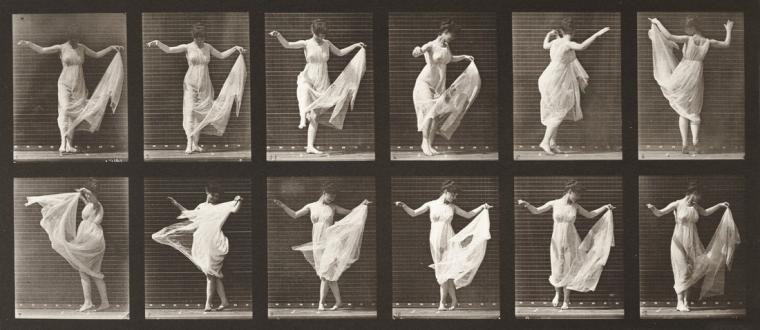
Eadweard Muybridge, English 1830-1904, Woman Dancing, Plate 187 from Animal Locomotion, 1887 (photo credit: Wikimedia Commons)
Through Sunday, November 5
Figge Art Museum, 225 West Second Street, Davenport IA
On display in the Davenport venue's Lewis Gallery through November 5, a selection of images demonstrating the artistry and technological feats of "action" photography can be admired and enjoyed in the Figge Art Museum's Body Movin: Photography of the Body in Motion, an exhibition that encourages viewers to contemplate the grace of the human form.
Featuring 20th century photography from the museum collection and on loan, this exhibit explores images of the body in motion, and each work, whether of people dancing, working, or at play, is relatable yet gives a fresh perspective on our own bodies. For millennia, artists have sought to express the physicality of the human form. Photography was the first medium allowing artists to document the instant of movement - something that still fascinates the public and photographers alike. Whether capturing the refined beauty of modern dance, the line and gesture of the body moving through space, or the blurred exuberance of children at play, the images in Body Movin: Photography of the Body in Motion give us insight into how people move through the world.
Included in the exhibition is the work of groundbreaking photographers such as Barbara Morgan (1900-1992) and Harold Edgerton (1903-1990). Morgan is known for images communicating the power and grace of modern dance. She collaborated with famed choreographer Martha Graham for decades, who stated of Morgan’s work, “It is rare that even an inspired photographer possesses the demonic eye which can capture the instant of dance and transform it into timeless gesture.” While Morgan captured the essence of modern choreography, Edgerton captured that which the eye cannot perceive. A doctor of electrical engineering, Edgerton developed a technique using short flashes of light to create still photographs of fast-moving objects such as birds in flight. Edgerton’s inventions influenced photography, as well as science, military surveillance, and filmmaking.
Body Movin: Photography of the Body in Motion will be on display through November 5, with regular museum hours 10 a.m. to 5 p.m. on Tuesdays through Saturdays (10 a.m. to 9 p.m. on Thursdays) and noon to 5 p.m. on Sundays. Museum admission is $4-10, with victors admitted free throughout the month of July, and more information is available by calling (563)326-7804 and visiting FiggeArtMuseum.org.








